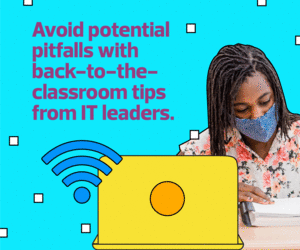Why Is Classroom Hygiene and Sanitization Important at K–12 Schools?
“While sanitation has always been important, the COVID-19 pandemic has heightened the public’s awareness of its importance in keeping people as healthy as possible,” says Karol Szacilowski, associate product manager of Enclosures and Cooling at Tripp Lite, a Chicago-based manufacturer of products to power and connect computers, networking equipment and electronic devices.
Schools are particularly at risk for the spread of infections, including COVID-19, says Dr. Ravina Kullar, an infectious disease specialist and epidemiologist and adjunct faculty at the University of California, Los Angeles. Indoor classrooms are crowded, she says, and in some cases poorly ventilated. Kullar adds that students younger than 12 are particularly at risk because there are currently no COVID-19 vaccines approved for that age group, while eligible students — and teachers — may not be protected due to vaccine hesitation.
“Infection prevention is key in a school setting,” says Kullar.
Can School-Issued Devices Contribute to COVID-19 and Flu Outbreaks?
Kullar suggests schools avoid having students share devices when possible to avoid passing germs. She says schools should have hand sanitizing stations readily available and recommends using solutions that are at least 60 percent alcohol – the level in most commonly used brands.
Schools also should sanitize shared devices after each use by an individual student, says Szacilowski.
DISCOVER: Read up on the do's and don'ts of cleaning school-issued devices.
“In some schools, students are able to take devices home,” he says. “We recommend sanitizing these devices as soon as the students arrive at school in order to mitigate the risk of spreading microorganisms from home to school. We recommend the same process before students take devices home at the end of the school day. This not only gives students, teachers and staff peace of mind, but also parents.”
Here are a few sanitization options available for schools to consider:
Tablets and Laptops
- Tripp Lite Charging Carts: Tripp Lite products can help meet district’s charging and sanitization needs. The company offers two 32-port options, allowing IT leaders to choose the cart that best meets their district’s needs. There is a cart for Chromebooks and laptops, and there is a cart for tablets. Both provide the same charging and ultraviolet sanitation benefits.
- Anywhere Cart: Schools looking for charging and sanitation solutions for individual classrooms should consider Anywhere Cart charging solutions. The company offers a lockable cabinet that holds up to 18 devices.
- Seal Shield: Districts seeking a solution for a smaller number of devices, such as staff and teacher tablets, might consider the charging and sanitizing cabinet from Seal Shield. It disinfects devices on four shelves without taking up much space in a classroom or school office.
- Microsoft: Microsoft offers tips to help keep its Surface devices clean on its Support page.
Hand Sanitizing
- CTA Hand Sanitizing Stations: Providing stations throughout school buildings encourages students and staff to sanitize their hands. While not a substitute for hand-washing, the availability of sanitizing stations can decrease the spread of germs and disease. When used as students enter the building, it helps eliminate germs they may bring into the school.
- Dr. Libeaute Sanitizer Refill: Buying hand sanitizer in bulk, such as the 1-gallon containers offered by Dr. Libeaute, ensures there is always enough to refill any sanitizing stations or classroom dispensers.
Sanitization Services
- SanitizeIT: This CDW Amplified™ service helps keep classrooms clean by collecting and sanitizing devices. Working with an organization to clean devices ensures staff and students aren’t forgetting that crucial step when left to do it themselves.
“It is important to frequently clean students’ devices to help keep the device looking and working great as well as reduce the spread the germs,” says Anthony Salcito, vice president of Microsoft Education Worldwide.
How Can Schools Keep Students Safe from Disease?
Schools should upgrade their ventilation systems before the start of the school year to help stop the spread of infection, Kullar says. Many of the measures schools have used to prevent the flu in previous years should be effective to curb the spread of COVID-19, she notes.
She says the key is to reinforce those measures and to ensure that school buses are included in sanitization planning as well.
LEARN MORE: How can smart technology help create healthy school buildings?
“Children are constantly touching their faces,” she says. “If they touch a computer that is shared with a child who is sick, they aren’t going to remember to wash their hands immediately.”
Kullar says these infection prevention measures will be particularly important as new variants continue to spread, including the Delta variant already circulating in the U.S., which affects younger populations more than older people.
“The pandemic isn’t over yet,” she says.










